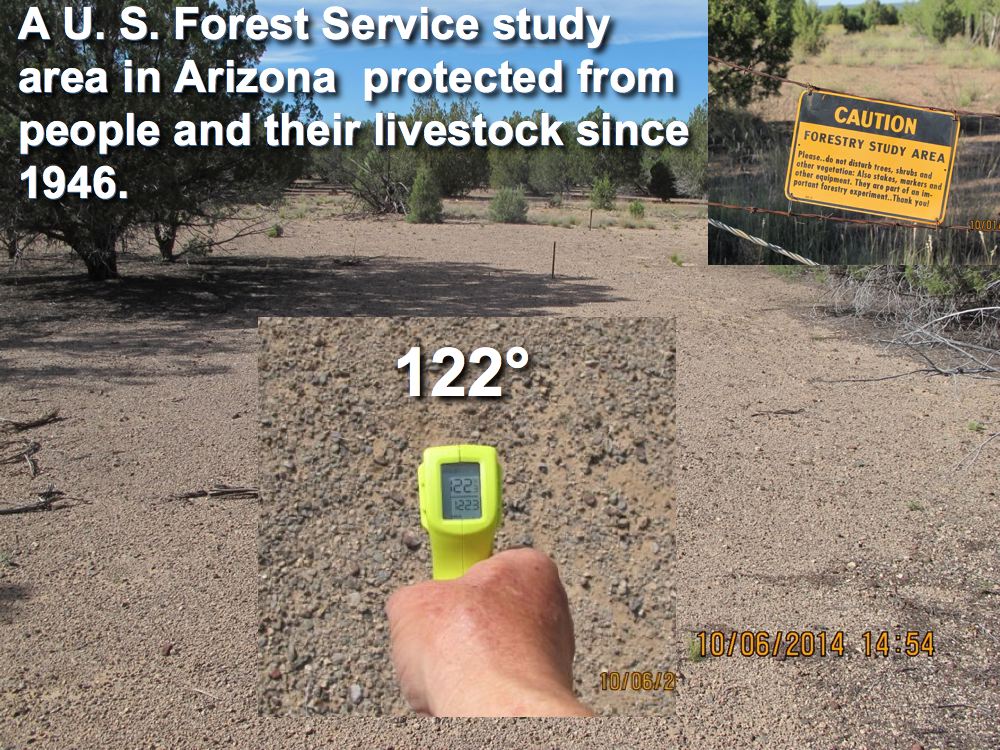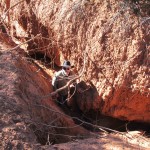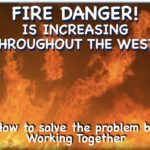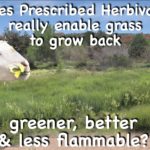How much do cows and grazing really contribute to Global Warming? Some groups say they are the greatest contributors of all, creating even more carbon loading than all forms of transportation combined.
I like to find things out for myself, on the ground so to speak. So, rather than read a bunch of studies in which I have little to no faith, I decided to try a technique which, as far as I know, no one else has tried.
I decided not to measure carbon dioxide. I didn’t have any real way to do that, and I didn’t want to go around counting, collecting and measuring cow farts, so I decided to measure warming itself.
To do that, I went to the local hardware store and bought a device which can read the temperature of a surface — the soil surface, for instance — from as much as two feet away. Having thus equipped myself I headed for some central Arizona rangeland.
First, I went with a group of agency people — U. S. Forest Service, Arizona Game and Fish, Arizona State Lands, etc.— to monitor transects on a well-managed ranch, a ranch on which I’ve studied, rode horses, taken photographs, and even done ecosystem restorations for a number of years.
Below is a photo of the group ”reading” one of those monitoring transects. While the monitoring team identified plants, counted them, measured their density, and recorded data, I took my new thermometer and took several readings. Because the area was almost entirely covered by grass (native grasses, I might add.), I took the most of my readings on areas of that sort. The reading illustrated along with the photo below (78°) is fairly representative. All of my readings were in the low to mid 80s and high 70s.
Next, while the rest of the team headed off to another transect, I went to visit one of my favorite counter-examples to the idea that land is healthiest if and where we protect it from the impacts of humans, especially from livestock grazing. This area is the U. S. Forest Service Drake Study area located not too far from Prescott, Arizona. The Drake has been protected from all human use (except study) since 1946. That’s a photo of the Drake Study Plot at the top of this post. So you don’t have to scroll back to the top, and for easy comparison, I’ll include another copy here:
How effective a means of countering global warming is removing livestock grazing. In central Arizona, at least, it appears to increase global warming rather than counter it by at least. If you’ve spent much time on this blogsite, you’ve heard of the Drake before, and you’ve seen photographs of it. If that’s the case, you know what it looks like, and if not, well, here it is — bare as a parking lot. I know it surprises most of you to encounter a piece of land that is ”protected” and, nevertheless, in this condition. It surprises virtually everyone I tell about it, but bare it is. Most people whom I tell about the Drake assume that it is bursting with growth when I tell them it has been protected from grazing for more than 65 years (68 and counting). I don’t intend to explain here why this is not the case, but if you want to know more about this apparent contradiction of environmentalist conventional wisdom just search the blogsite for ”Drake,” and you’ll get the picture. Actually, you’ll get a lot of them.
Right here and now, I’m using the Drake purely to illustrate the fact that, in some cases at least, protecting the land contributes significantly more to planetary warming than grazing it (as much as 44° in this case).
I checked the temperature of several areas, both grassy and bare, that day and the temperature difference remained about what I’ve reported. I did find that green grass was a little cooler than grass that had completed its growth cycle and had begun to dry and turn yellow. This is significant because the majority of green grassy areas I found were on the well-managed ranchland.
What that all adds up to is areas that were grazed were consistently and significantly cooler than areas that were protected from grazing, as much as 44° (36%)cooler. What makes this even more significant is that the most effective way I know of turning bare and therefore hot areas into grassy and therefore cool areas is to use animals such as cattle to do so. I know this contradicts the conventional wisdom, which tells us that cattle make the land bare, therefore it has to be impossible for them to make it green and lush. For more on this check just about any (or all) of the other posts in this blog.







